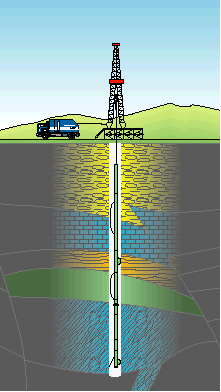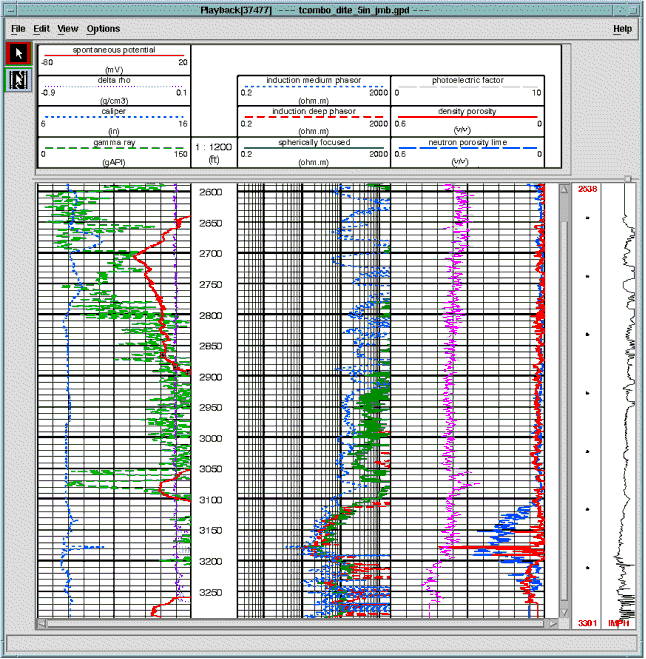
As a well is drilled, core samples, cuttings, well logs, and test results are carefully watched in order to find out as much as possible about the area surrounding the wellbore. Well logs are the primary means of determining formation depth, oil in place, and many other pieces of critical information. A log is a record of information about the geological formations that have been drilled through. There are many types of logs, and each is used to determine specific information about the subsurface.

Wireline logging is performed from a logging truck. The logging company is called a few hours before the wellbore will be ready for logging. The truck brings with it the various tools that are used to take downhole measurements, the electrical cable and winch that will lower the tools downhole, and the computer s needed to transmit, receive, and process the signals from the tools. In addition, a power supply is needed. Wireline logs are acquired by lowering a tool often referred to as a sonde, generally a long metallic cylinder that can be up to 90 feet long, into the wellbore on a metal line. Generally, the tool is lowered to the bottom of the wellbore, calibrated, and then measurements are taken from the bottom of the wellbore up. The Schlumberger brothers invented wireline logging, and this is still a major focus of the oil field services business today. By looking at well logs from nearby wells, geologist can determine the depths of formations of interest, and can make a contour map of the formation, the thickness of the formation, etc.

The sonde consists of sensors and a cartridge. The cartridge carries electronics to power the sensors, process the resulting measurement signals, and transmit the signals up the cable. The sonde generally measures electrical, radioactive, or acoustical properties of the formations. The sonde sends signals up the wireline to the recording truck, where they are analyzed by computer, and displayed on graphs that can be interpreted by geologists and engineers. Besides being used to determine the depth of the formation, logs can be useful in determining formation porosity, permeability, and the types of fluids in the formation. Other down-hole tools may be used in a similar manner: for example, the dip of the formations may be measured by a dip meter, and samples of the formations of interest, called sidewall cores may be taken.
The following diagram is an example of a wireline log known as a triple combo. The log is divided into individual pieces, called tracks. The left track displays the Spontaneous Potential, Caliper, and Gamma Ray. Next, is a depth track. The next track displays the Medium Induction, Deep Induction, and Spherically Focused curves. In the next track, the Photoelectric Factor, Density Porosity, and Neutron Porosity are displayed.

The Spontaneous Potential (SP), or self-potential, is an electrical measurement that is generally taken when fresh-water drilling mud has been used. It records the weak currents that flow naturally in the rock next to the wellbore. The curve may be used to determine the boundaries and thickness of the rock formation.
The Caliper is a tool that has two or more adjustable arms that can measure the diameter of the wellbore. This can help determine not only the wellbore diameter, but also places where the wellbore has been washed out, or eroded.
The Gamma Ray log is a radioactive log that measures the natural radiation around the wellbore. Shales tend to give off a higher level of gamma radiation than other types of rock, which can be detected by this tool. The mineral composition of the shale can be determined by analyzing the energy spectra of the gamma ray population.
The Induction curves are measuring the Conductivity of the wellbore. Formations that contain oil are less conductive of electricity than water-bearing formations. When compared with porosity measurements, the conductivity can aid in determining where oil zones occur. The medium induction only measures the area immediately around the wellbore, and the deep induction measures the area deeper into the formation, past the effects of drilling mud. Conductivity and Resistivity are reciprocals of each other.
Porosity is the amount of open space between individual grains of rock. This property allows fluids such as hydrocarbons to be trapped in a reservoir. There are several tools used to measure porosity, notably Density, Neutron, and Sonic. Any of the porosity tools measure porosity in any type of rock, but each tool may be adversely affected by different things. The Density log is a radioactive log that is adversely affected by gas, shale, and bad borehole conditions. The Neutron log is a radioactive log that bombards the formation with neutrons in order to measure the porosity of formations. It is adversely affected by gas and shale. The Sonic log is adversely affected by gas and unconsolidated formations. When a combination of porosity tools is used, the mineralogy may be inferred, as well as the porosity. Overlay interpretation techniques provide quick identification of gas zones.
The CMR tool is a magnetic resonance logging tool that is extremely valuable for formation evaluation. The CMR tool provides measurements that are a reliable source of information on producibility, permeability and water cut. Very thin permeable zones may be identified with this tool.